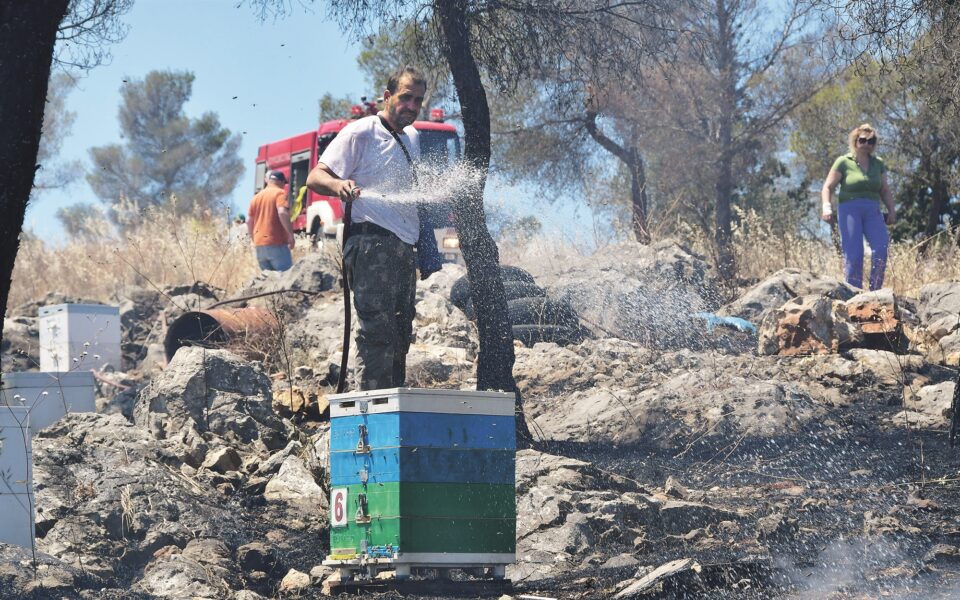The human hand behind the fires
Negligence, ignorance and carelessness cause most of the country’s blazes, data show

Who lights the “fuse” that sparks wildfires and why? There are no easy explanations, as the Fire Service’s investigators have not discovered the cause of most wildfires in Greece. While it is true that individual arsonists or groups of arsonists acting according to a deliberate plan have been fingered in several cases, most appear to be caused by irresponsible citizens who inadvertently caused the spark – especially during periods of high temperatures and low rainfall – that led to such widespread destruction. According to data from the Fire Service that has been processed by environmental protection organizations, only a small proportion of blazes are caused by natural phenomena like lightning.
More specifically, the data show that 35% of wildfires in Greece are thought to be the result of negligence, though this is a very broad category with many different levels of culpability.
This category includes, for example, short circuits on the power grid resulting from poor maintenance and failure to properly clear flammable materials. This appears to be a “systemic” and nationwide problem that is believed to be responsible for many blazes.
The category also includes the burning of branches, brush, crop residue and trash in fields and farms – a major culprit – not to mention fire from smoking beehives, sparks from welding or other such activities, carelessly discarded cigarettes, fire from ammunition discharged during military exercises, and barbecues and campfires that have gotten out of hand. Illegal landfills are also a big problem, especially in or near wooded areas, as trash contains a large amount of flammable materials.
The Fire Service data go on to show that around 20% of wildfires are deliberate, meaning the product of arson, while the cause of the remaining 45% has not been determined.
Among the people who have been accused of arson by fire investigators over the past few years, some 20% have faced charges of starting the fire deliberately; the rest were accused of gross negligence. Most of the accused were farmers (26%), followed by pensioners (23%).
Off-plan construction
The destructive force of wildfires in Greek forests is further exacerbated by off-plan construction, which has taken hold all over the countryside, creating residential islands inside farm and brushland, as well as near or even right inside forestland. Some used to argue that the presence of residences near or in forests could be a good thing for dealing with wildfires as they could be spotted before they got out of control or because the creation of roads in the area would help firefighters reach the blaze more easily. There are many technical tools for monitoring forests today that render such arguments void, while a network of fire lookout towers would serve such a purpose much more effectively.
When a fire breaks out in forestland where there are one or more houses, devising a strategy for dealing with the blaze becomes a lot harder
Moreover, mounting evidence shows that building outside the town plan, especially in a scattered way or inside the natural environment, causes a string of problems that make the likelihood of wildfires that much greater. To begin with, installing power lines through unbuilt stretches of forest or brushland to reach remote houses can cause sparks. The same can happen with construction work or even maintenance and repairs on these houses. The biggest problem, however, is the negative effect on firefighting efforts.
An officer in the Fire Service speaking to Kathimerini on the condition of anonymity explained that when a fire breaks out in forestland where there are one or more houses, devising a strategy for dealing with the blaze becomes a lot harder. Dumping water onto the blaze from aircraft, for example, has to be much more cautious, or surgical in nature, so that it doesn’t damage private property. What’s more, firefighters will dedicate more energy to trying to save a house to the detriment of the broader aim of getting the blaze under control.
Beehive smoking
Another factor that needs to be considered with regard to how we deal with the country’s forests – especially given how climate change has made them that much more vulnerable to fire – is how a string of traditional activities are carried out.
One of these is how beekeepers smoke their hives, either to calm the bees down or to initiate a feeding response.
“Even though beekeepers are people who are particularly mindful about the protection of the environment – the health of their bees depends on it, after all – mistakes are, unfortunately, made every once in a while,” a beekeeper who gives his name only as Lefteris, tells Kathimerini.
The Fire Service data show that several blazes can be attributed to such mistakes, which is why the legislation concerning the matter is so specific. It states that beekeepers can only smoke their hives up until noon and only when the wildfire risk factor in their area is at 1 or 2 (low or moderately low). Moreover, before hives installed in forests can be smoked, the beekeeper needs to clear an area of 5 meters around the bee farm of all flammable material, and make sure that the nearest trees are at least 10 meters away. There also needs to be a minimum of 200 liters of water on hand in case a fire breaks out, while the hives need to be properly labeled with the owner’s details.
“One of the more common mistakes made by my colleagues is that they light their smokers on the ground. It should always be lit on the back of the truck and it should always be done very carefully. And we never, ever, put it down on the ground,” says Lefteris.
Smokers are usually filled with pine needles, cypress branches or some other natural kindling. The process of emptying the smoldering material is also risky.
“What should go without saying is that we need to be careful in any interaction we have with our forests,” adds the experienced beekeeper.





